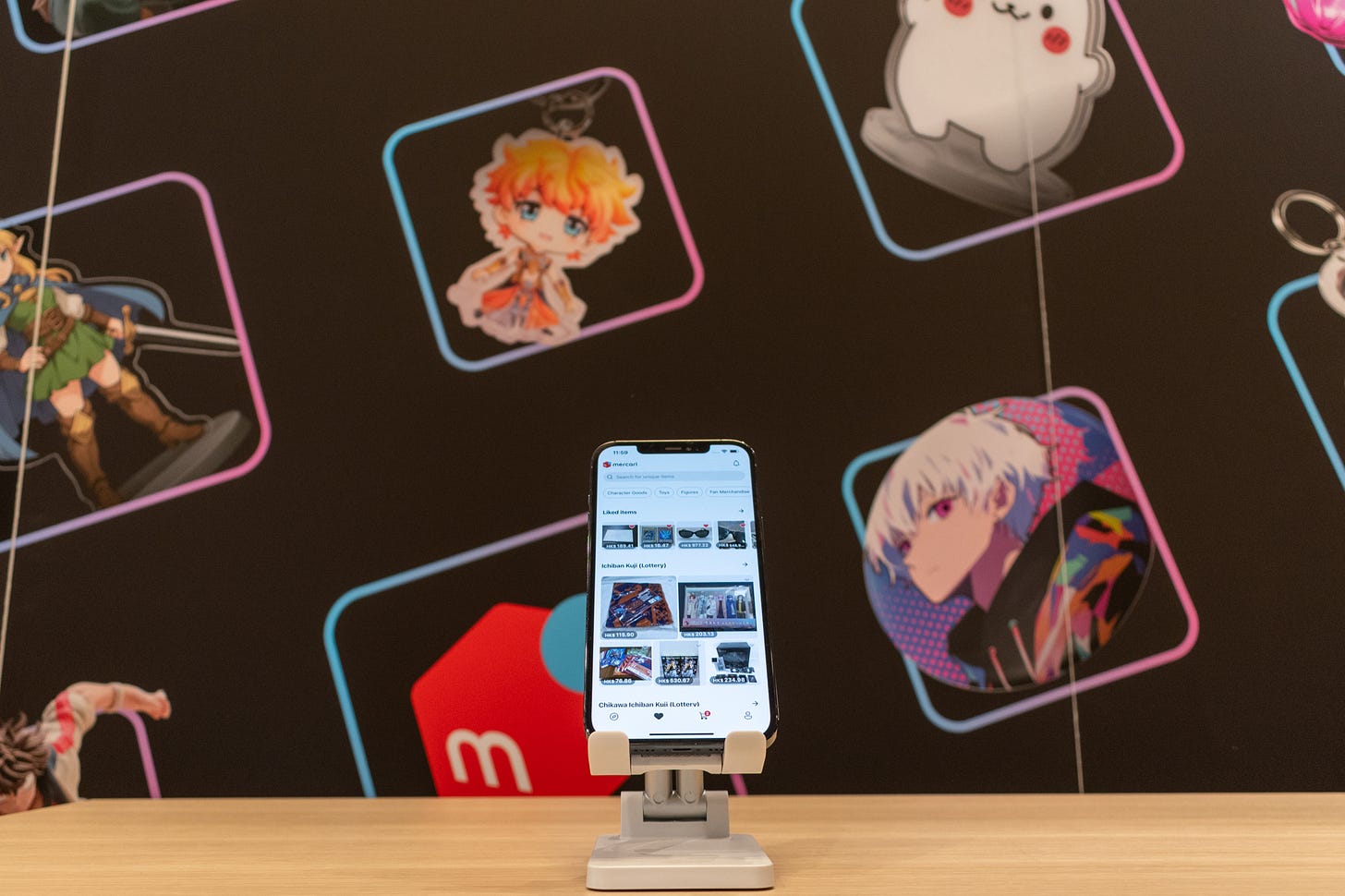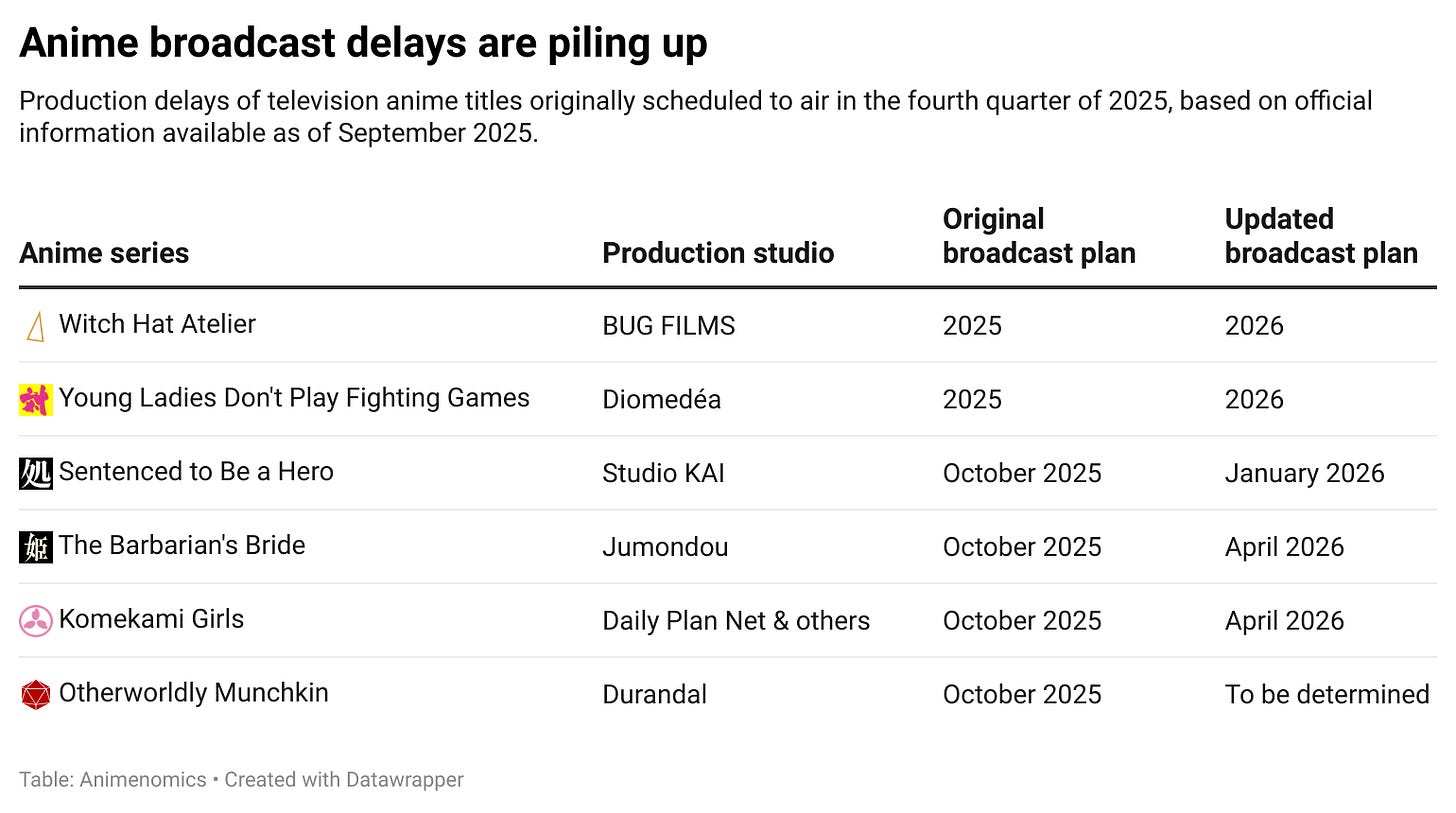Crunchyroll relaunches digital manga service
Plus: Multiple October anime premieres delayed; Mercari to open global marketplace app for secondhand merch; Newspaper starts 'oshikatsu' advertising; and more
This is your weekly Animenomics briefing, covering the business of anime and manga. Today is Wednesday, October 1, 2025.
In case you missed it: Japan’s first permanent Dragon Ball store selling merchandise from the manga and anime franchise will open in Tokyo Station in November.
Crunchyroll outsources new manga app development
Crunchyroll will launch its new digital manga service in the United States and Canada next week during New York Comic Con, reentering digital manga distribution nearly two years after shuttering its previous self-developed platform.
Why it matters: Crunchyroll’s return to digital manga distribution accelerated after Sony’s ¥50 billion (US$335 million) investment in Kadokawa last year, which gave the entertainment conglomerate rights to distribute Kadokawa manga titles digitally.
Yes, but: Crunchyroll didn’t make the platform, instead outsourcing development and operation to Tokyo-based Link-U Technologies, which built international digital manga services like Shueisha’s MANGA Plus and Square Enix’s Manga UP!
In Japan’s domestic manga industry, Link-U is best known as the developer of Shogakukan’s MangaONE, which launched in 2014 as the industry’s first digital manga platform to utilize in-app purchases.
For enabling the spread of digital manga through MangaONE, Manga UP!, and other publisher-affiliated platforms, Link-U received the 2022 digital publishing award from Japan’s Association for E-Publishing Business Solution.
Since announcement of the company’s involvement last Friday, parent Link-U Group’s share price on the Tokyo Stock Exchange has more than doubled as of Wednesday.
How it works: Crunchyroll Manga is an add-on subscription on top of Crunchyroll’s anime subscription service and will be available as a mobile app and on the web.
Crunchyroll Manga will share revenue with publishers based on user engagement, similar to Crunchyroll’s anime revenue-sharing model, chief content officer Asa Suehira told Fast Company.
Between the lines: Crunchyroll said manga publishers like Square Enix, AlphaPolis, and Shueisha have joined as licensing partners, but Kodansha is noticeably missing.
Kodansha was a key partner in Crunchyroll Manga’s previous iteration since its launch in 2013, but restrictive licensing agreements limited how much users could read on the platform, Suehira told Fast Company.
The publisher released a standalone manga app in the United States in 2023 and began withdrawing titles from Crunchyroll Manga, leading to the platform’s shuttering later that year.
Under the new arrangement, Link-U will acquire content for Crunchyroll Manga, shifting licensing responsibilities away from Crunchyroll.
Production bottlenecks delay October anime premieres
Six television anime series scheduled to begin airing in October have been forced to delay their premieres until 2026, raising concerns about the sustainability of current anime production timelines.
Why it matters: These are the highest number of television anime production delays since the end of 2022, when the relaxation of COVID-19 restrictions in China resulted in a rise in infections that delayed the work of overseas animators.
Zoom in: One notable delay is the anime adaptation of Kamome Shirahama’s Witch Hat Atelier manga by BUG FILMS, a studio founded in 2021 by production company Twin Engine.
BUG FILMS led the animation work on Zom 100: Bucket List of the Dead in 2023, which also encountered production delays that led to the postponement of its three final episodes by months.
What’s happening: Major anime studios with the financial means to hire animators in-house have been hiring Japanese animation talent as full-time employees in recent years, creating a labor crunch for smaller studios.
These smaller studios often end up outsourcing large portions of animation work to subcontractors abroad in countries like China and South Korea, increasing the risk of production delays.
This year in particular, the fourth quarter anime season coincides with China’s National Day and South Korea’s Chuseok holidays, stopping work in many local studios, according to anime journalist Atsushi Matsumoto.
The bigger picture: As previously reported by Animenomics, anime studios are doing more business transactions with foreign companies than just two years ago, according to a survey conducted by the Teikoku Databank credit reporting agency.
Around 10 percent of Japanese anime studios now have business deals with South Korea, up from just over 6 percent in 2023.
Clippings: Mercari announces global marketplace app

Japanese e-commerce giant Mercari will launch a mobile app to allow consumers in more than 50 countries to buy products listed on its domestic marketplace platform, increasing availability of secondhand products like anime merchandise. (The Nikkei)
Cross-border purchases made by U.S. consumers on Japanese e-commerce sites rose 8 percent last year to ¥1.6 trillion (US$10.8 billion), and purchases by Chinese consumers rose 8.5 percent to ¥2.64 trillion (US$17.8 billion), according to a study by the Ministry of Economy, Trade, and Industry.
Demon Slayer’s social media channels will stop officially reporting Demon Slayer: Infinity Castle’s domestic box office earnings after the film crossed ¥35 billion (US$237 million) in ticket sales revenue last weekend. (Otaku Lab)
Zoom out: Eleven weeks into its release in Japan, Infinity Castle has earned 10 percent more in box office sales domestically than Demon Slayer: Mugen Train did in the same period of time.
YouTube Japan will stream selections of more than 30 anime titles this month as part of YouTube Anime Week, with several titles such as Golden Kamuy, Kaiju No. 8, and Milky☆Subway: The Galactic Limited Express made available globally. (Mynavi News)
Entertainment analytics firm GEM Partners and anime community service provider MyAnimeList are jointly developing dashboards for GEM Partners clients to measure global anime popularity based on MyAnimeList user activity. (Press release)
Los Angeles’s Anime Expo convention has been receiving more television coverage in Japan thanks to increasing participation in the event by Japanese broadcasters who are investing in anime production committees, says its organizer. (Nikkei xTrend)
A Lionsgate film executive boasted last year that the Hollywood studio could use AI to create an anime based on the John Wick film franchise, but its partnership with New York City-based tech startup Runway has run into complications when making AI-generated television shows and movies. (TheWrap)
The Mainichi enters market for ‘oshikatsu’ advertising
The Mainichi, one of Japan’s national daily newspapers, has begun allowing readers to buy full-page advertising for their favorite pop idols, musical artists, virtual YouTubers, and anime characters.
Why it matters: The offering is a sign that Japan’s spending-driven fandom culture known as oshikatsu is becoming an economic force that domestic advertising vendors can no longer ignore.
How it works: To run the program, The Mainichi is partnering with JR East Marketing & Communications, which operates the Cheering AD web platform for individuals or groups to buy ad placements on billboards nationwide.
A full-page ad placement on The Mainichi’s morning newspaper costs between ¥350,000 (US$2,300) and ¥3.05 million (US$20,000) depending on the geographic target market.
Earlier this year, fans of Bandai Namco’s video game and anime franchise The Idolmaster raised ¥1.06 million (US$7,100) to buy ad space on two train station billboards to celebrate the franchise’s 20th anniversary.
By the numbers: As previously reported by Animenomics, oshikatsu could contribute up to ¥3.5 trillion (US$23.6 billion) to the Japanese economy, about 2.1 percent of the country’s total annual retail sales.
According to a nationwide survey completed earlier this year, JR East Marketing & Communications estimates that Japan’s market for fan-purchased advertisements stands at ¥76.9 billion (US$518 million).
Animenomics is an independently run and reader-supported publication. If you enjoyed this newsletter, consider sharing it with others.






I'm wondering how this manga service is going to work. I've been looking for different sites to find manga since buying every single manga I want to read is kind of impossible. I hope it works, but the launch will probably have some bugs.